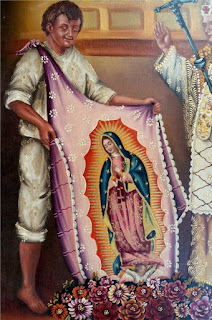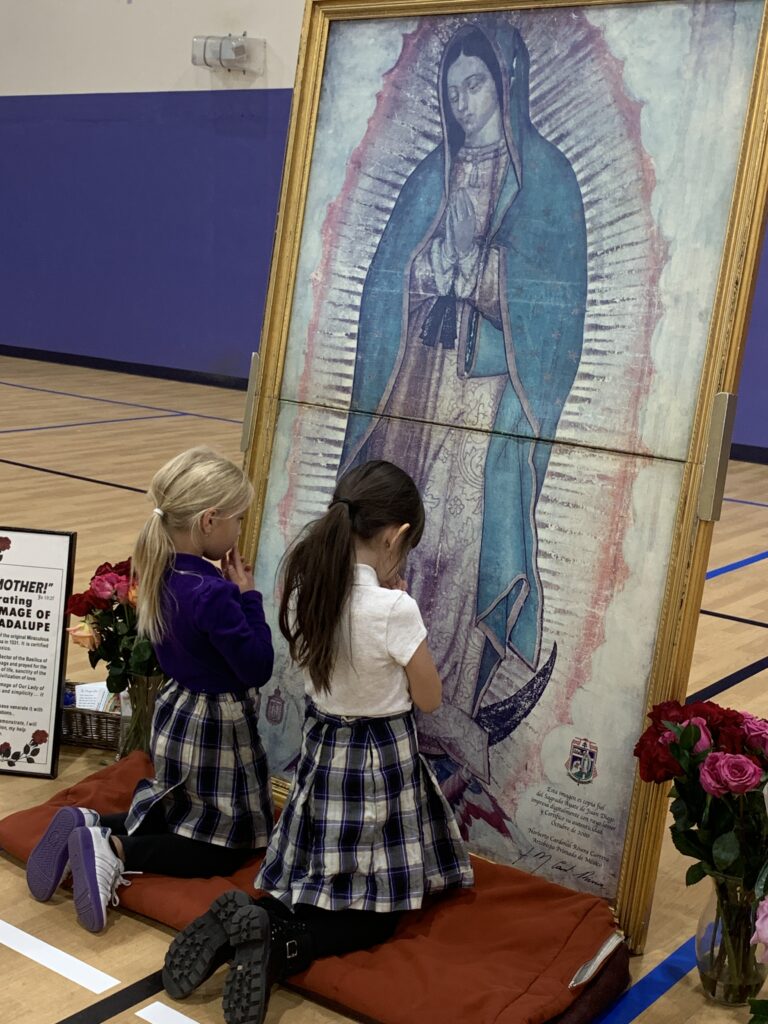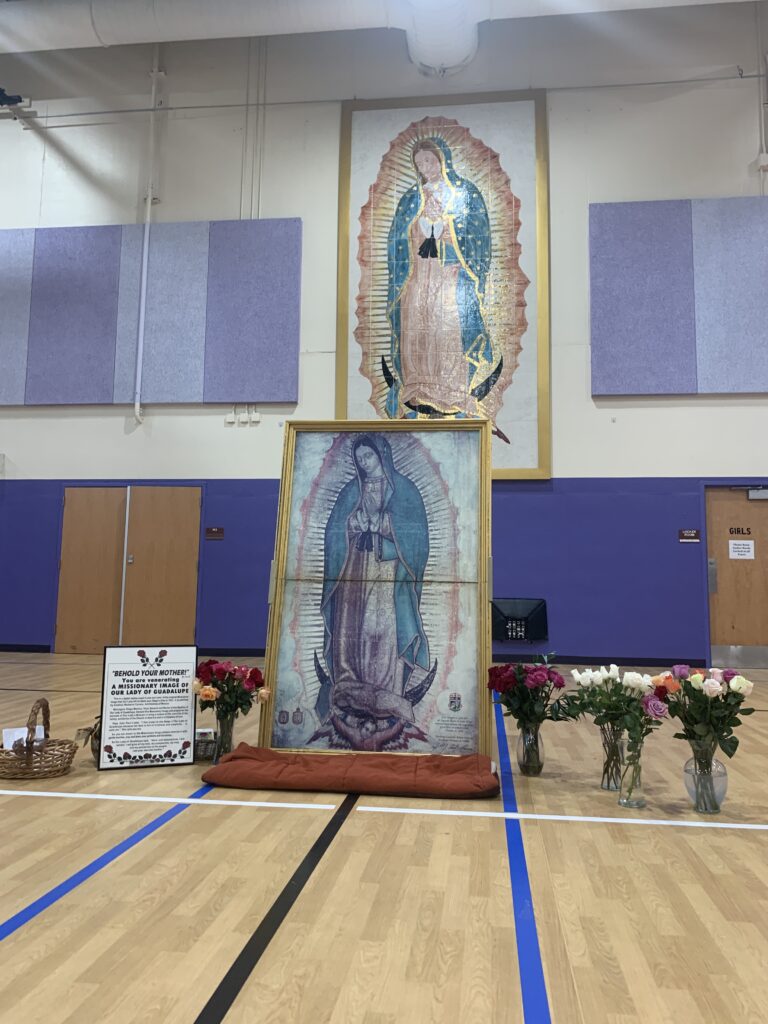
On December of 1531 our blessed Mother appeared to the native American Saint Juan Diego at Tepeyac Hill in the area of modern-day Mexico City. Our Blessed Mother actually appeared four times to Saint Juan Diego and once to his dying elderly uncle, Juan Bernardino. The fourth appearance to Saint Juan Diego was the most wonderful. A brief account of the apparitions will help to appreciate better God the Father’s purpose in sending the Blessed Mother to the American continent at Tepeyac and the important meaning of devotion to Our Lady of Guadalupe.
The first apparition took place on December 9, which at that time was the Solemnity of the Immaculate Conception in the Spanish Empire, of which Mexico was then a part. Our Blessed Mother appeared to Saint Juan Diego, an older native American who had recently lost his dear wife.
Juan Diego heard beautiful music and a beautiful voice calling out his name. Our Blessed Mother appeared to him as the “woman clothed with the sun” of the Book of Revelation, pregnant with the Child Jesus. She instructed Juan Diego to go to the house of Bishop Juan de Zumárraga and to request that a chapel be built in her honor on Tepeyac Hill so that she might show the infinite majesty and mercy of God to all His children of America.

The local bishop—an important church official—demanded that Juan Diego provide a sign that would prove the Virgin Mary had really appeared to him before he would agree to build a church on the site. The Virgin Mary appeared to Juan Diego again on December 12 and miraculously showed him where to pick roses, even though it was winter, to take to the bishop as proof that she had really appeared. Juan Diego collected the roses in his cloak, went before the bishop, and then opened his cloak to show him the roses. Dozens of roses fell to the floor and his cloak had a beautiful picture of the Virgin Mary inside. The bishop was stunned by the miracle and ordered that a church be built in her honor on Tepeyac Hill.
Saint Pope John Paul II
‘The Basilica of Our Lady of Guadalupe will be the centre from which the light of the gospel of Christ will illuminate the entire world by means of the miraculous image of His mother.’
Saint John Paul II authorized the creation of the digital replicas of the miraculous original image of Our Lady of Guadalupe in 1979. These consecrated images have been declared as Authorized Relics that extend the graces of evangelization, conversion and truth to those nations which receive them; the same graces as extended in 1531.
On Monday, October 16th, St. Clare of Assisi students and families participated in the veneration of our Mother Mary.




Juan Diego himself died in 1548, seventeen years after the apparitions, at the age of 74. On May 6, 1990, Pope Saint John Paul II, during his second pilgrimage as Pope to the Shrine of Our Lady of Guadalupe, declared Juan Diego blessed. Pope Saint John Paul II later canonized Juan Diego on July 31, 2002.
THE MIRACULOUS IMAGE OF OUR LADY OF GUADALUPE
THE FABRIC
The “Tilma” (a kind of cloak worn by native Mexicans) of Juan Diego that bears the miraculous Image of Our Lady of Guadalupe is a coarse fabric made from the threads of the maguey cactus fiber which usually lasts no more than 20 to 30 years, and yet the fabric has maintained its structural integrity – without cracking or fading, or any sign of deterioration for nearly 500 years. It consists of two pieces of coarse cloth fibers of about 1.70 by 1.05 meters (69.99 by 41.3 inches) held together in the center by a seam of thread made of the same material and is typical of the cloaks used by the Nahuas in the 15th and 16th centuries called “Ayates.” The seam is visible up the middle of the figure, turning aside from the face.

For centuries the Tilma was exposed to the rigors of all natural elements without any kind of protection against infrared and ultraviolet radiations from the tens of thousands of candles near it and the humid condition, dusty and salty air around the Basilica. Despite the constant contact of hands and kisses of thousands of pilgrims who venerated the Image and the continuous manual handling of the Tilma including the many different objects that touched it during the countless times it was subjected to scientific examinations, the Tilma remained in a state of perfect condition.
Callahan and Smith further discovered that the Tilma maintains a constant temperature of 36.6º to 37º, (98.6 Fahrenheit) the same as the body of a living person. Carlos Fernandez del Castillo, a gynecologist, examined the image and has determined that the gynecological measurements of Our Lady’s physical dimensions indicated a woman who is pregnant entirely consistent with the stage of pregnancy on December 9th for Jesus birth to occur on Christmas day. A stethoscope was placed below the black band at the waist of Our Lady (a sign that she is pregnant) and heard rhythmic repeating heartbeats at 115 beats per minute, the same as that of a baby in the maternal womb.
On December 22, 1981, at the Observatory Laplace Mexico City, Father Mario Rojas and Dr. Juan Hernández Illescas, a medical doctor and amateur astronomer, performed an astronomical study of the Image and analyzed the stellar arrangement that appear in the Mantle of Our Lady. They surprisingly discovered that the stars stunningly and accurately map out the various constellations of the Mexican sky. Even more remarkable is the “star map” on the mantle is in the reverse (the cardinal axis rotated 90 degrees counterclockwise): providing a view of the constellations from beyond them, as would be seen looking through them towards the earth. The constellations are consistent with what astronomers believe was in the sky above Mexico City on the day the apparition occurred – in the winter-morning solstice of December 12, 1531, Saturday, at 10:26AM.
OUR LADY’S CLOAK
Our Lady’s cloak has 46 stars: 22 on her right side, and 24 on her left side. These 46 stars are the most brilliant stars that surround the horizon of the Mexican Valley which have been identified. The main constellations of the Northern sky can be seen on the right of the mantle. On the left, the Southern ones which can be seen from the Tepeyac in winter at dawn. The East is situated in the upper part and the West in the lower part. The Mantle is 4 opened and there are other groups of stars which are not marked in the Image, but they are present in the sky. The Boreal Crown is located above the Virgin’s head; Virgo is on her chest, in the region of her hands. Leo on Her womb, precisely above the sign of Nahui Ollin, with his main star Regulo, the small king. Gemini, the twins, is found in the region of the knees and Orion is located where the Angel is.
It has also been found that by imposing a topographical map of central Mexico on the Our Lady’s dress, the mountains, rivers, and principal lakes coincide with the decoration on the dress.
OUR LADY’S EYES
Scientists from the NASA Research Centre have conducted extensive tests on the fabric and image and have discovered no scientific explanation, since the picture is neither painted, dyed, or woven. Digital enlargements of the Image were made and it was discovered that the reflection of Bishop Juan de Zumárraga looking in astonishment could clearly be seen in the pupil of Our Lady’s eyes. Further study of the photographic enlargements and rigorous investigations of Our Lady’s eyes (only about 1/3rd inch in size), have revealed not only the minuscule human image of a bearded man clearly identifiable in the eyes that no artist could have painted, but all the optical imaging qualities of a normal human eye, such as light reflection, image positioning, and distortion on the cornea which are impossible to obtain on a flat surface. When the eye of Our Lady is exposed to light, the retina contracts, and when the light is withdrawn, it returns to a dilated state, just as happens with a living eye. Our Lady’s eyes have been ophthalmologically determined to be alive on the Tilma!
To read more about Our Lady of Guadalupe click here.
